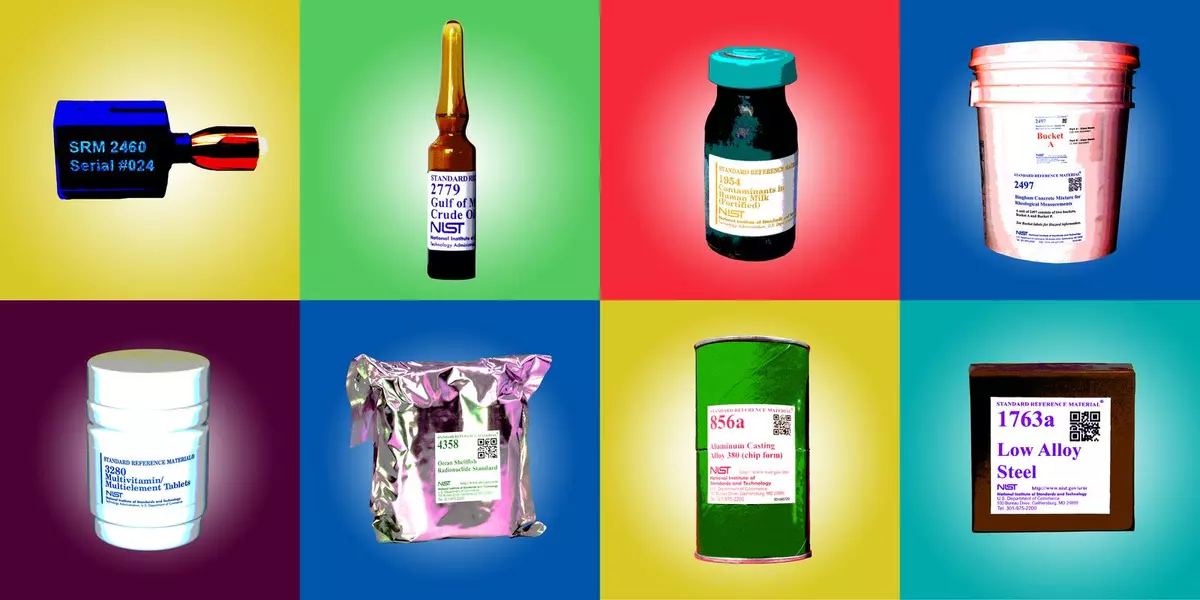
Measurements Matter
How NIST Reference Materials Affect You
In 2012, Consumer Reports announced startling findings—with potentially serious public health ramifications.
The publication investigated arsenic levels in apple juice and rice and found levels of the toxin above those allowed in water by the Environmental Protection Agency. The articles pointed out that there were no rules about allowable levels for arsenic in food.
The Food and Drug Administration responded by issuing a limit for arsenic levels in apple juice and, in 2016, for infant rice cereal. But the damage was already done.
It’s a funny quirk of human psychology: we take the most important things for granted—until it all goes wrong.
You probably don’t often question whether the food you buy in the grocery store is safe. Or if the lab where your doctor sends your samples accurately calculated your vitamin D levels.
But imagine, for a moment, how much more difficult it would be to go about your daily life if you didn’t have the information those measurements provide.
How would you decide what is safe and healthy to eat? How would you know if you were getting enough vitamin D or if your cholesterol levels were too high?
That's one of the big reasons NIST exists—to reduce uncertainty in our measurements and increase your confidence in the information you use to make important decisions in your daily life.
And part of the way NIST does that is through Standard Reference Materials (SRMs).
Standard Reference … what?
The government has acronyms for seemingly everything. At NIST, one even has a registered trademark: SRM® is the “brand name” of our certified reference materials, the generic term for these vital tools. Many other organizations measure and distribute certified reference materials, but only NIST has SRMs.
So what exactly is an SRM or certified reference material?
It can be difficult to explain, because SRMs are actually a lot of different things. In fact, NIST sells more than 1,000 different types of SRMs, from gold nanoparticles to peanut butter.
NIST has very carefully studied each of its SRMs, and it’s these characterizations, rather than the materials themselves, that customers pay for. SRMs serve a variety of purposes but are mostly used by other labs and members of industry to check their analytical measurements and to perform other kinds of quality-control tests.
Steve Choquette, director of NIST’s Office of Reference Materials, says SRMs are like widgets, tools that provide a service or help you complete a task. In this case, SRMs give manufacturers access to a level of measurement accuracy they wouldn’t otherwise be able to obtain.
“What an SRM really does is give our customers the highest quality measurements in a form they can easily use,” Choquette says.
Peanut butter—SRM 2387—is an excellent example. NIST scientists know exactly how much fat, salt, sugar and other nutrients are in the peanut butter, and they’ve recorded those amounts on a certificate that’s sold with the SRM. When an SRM user measures the NIST peanut butter with his or her own instrument, he or she should get amounts that match the certificate. If not, the manufacturer knows the machine must be adjusted.
NIST is a nonregulatory agency, which means it doesn’t set the rules for things like food and water safety. However, manufacturers frequently use NIST standards such as SRMs because they are a reliable, science-based means to demonstrating compliance with the rules set by regulatory agencies.
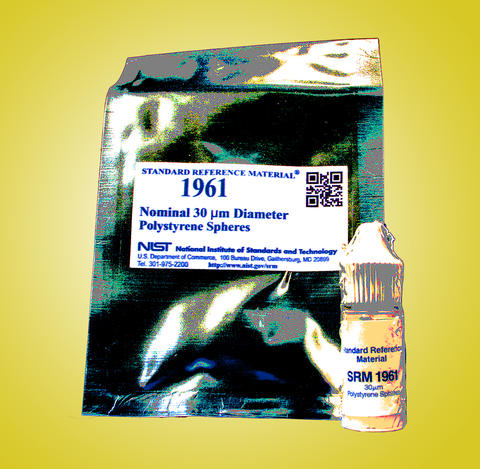
Weird SRM: Space Beads
Many products such as medicines, cosmetics, concrete, paints and food products contain small particles, and the size of those particles can play a big role in how well those products work.
Small particles are not always welcome, however, as is the case with pollution.
At other times, scientists just want to be able to compare a particle of a known size against a particle of an unknown size.
To satisfy needs like these, NIST and NASA collaborated to make SRM 1961, also known as “space beads.”
Microscopic in size, the space beads were made in the microgravity environment of the Space Shuttle Challenger during one of its missions in 1984.
The 30-micrometer beads come in 5mL vials, and each vial contains about 40 million beads.
The lack of gravity in space allowed NASA astronauts to manufacture perfectly spherical, stable beads, which made for more consistent measurements.
Does your food measure up?
Like the peanut butter SRM, many NIST SRMs are food products. These SRMs help the food industry comply with various U.S. food regulations such as those requiring nutrition facts labels. Regulators can be sure those labels are accurate when producers use SRMs to ensure their measurement instruments are properly calibrated.
In the lab, Joe Katzenmeyer, senior scientist and strategic analytical manager at Land O’Lakes, uses the SRMs for nonfat milk powder, infant formula and meat homogenate (a canned pork and chicken mix).
“We most often use NIST SRMs when developing a new testing procedure, and we need to know that a result is the ‘correct’ result,” Katzenmeyer said. “NIST values are established through a very thorough process and by labs across the country. This gives a high credibility to their established values.”
And that’s how you can be confident in the nutrition facts labels, too, so you can make healthy decisions about what to eat.
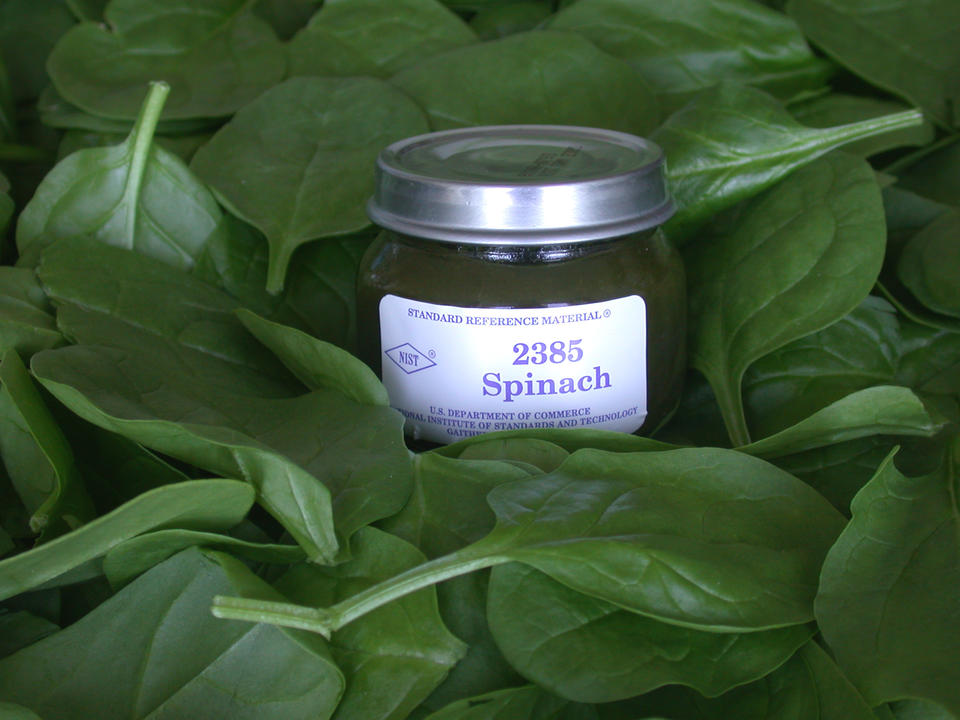
NIST SRM 2385, spinach.
But NIST food SRMs don’t just help you accurately count your carbs.
Remember the concern about arsenic in apple juice and rice? NIST already had a rice flour SRM, but NIST researchers recently added measurements for different types of arsenic. And, NIST is in the process of making an SRM for apple juice that will include levels for various forms of arsenic as well. Government agencies, like the Food and Drug Administration, can use these SRMs to ensure that arsenic levels in the foods we eat are safe.
And both health and safety are driving forces behind another type of NIST SRMs—those for dietary supplements.
Marketers can make some pretty strong claims about their products. But do so-called “superfoods” like green tea or blueberries live up to the hype? The first step in finding out is to carefully measure the properties of these foods.
That’s why NIST makes SRMs for green tea and blueberries, as well as multivitamins, St. John’s Wort and Ginkgo biloba, among others.
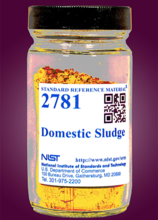
Weird SRM: Domestic Sludge
As you might not have guessed, domestic sludge refers to the muck that collects at wastewater treatment plants. And it’s teeming with all kinds of cooties and contaminants: antibiotics, pesticides, oil, heavy metals like lead and pretty much whatever runs downhill.
NIST’s domestic sludge comes from a sewer in Denver, Colorado. Scientists collect the sludge, dry it out, grind it up into a uniform powder and analyze it.
Why does NIST do this gross thing? For science, of course.
Domestic sludge is often collected and sterilized and used as soil conditioner and fertilizer. It’s the ultimate form of recycling.
People need to be able to run tests on this sludge so that they know their efforts to detoxify it, by leeching out the heavy metals and other nasty things, have been successful. Scientists need a reference material, a known quantity that they can compare their samples against and be assured of the accuracy of their measurements.
SRM 2781 is that known quantity.
A medical measurement marvel
Nearly 74 million Americans have high levels of LDL cholesterol—that’s the bad kind. Those with high cholesterol have twice the risk of heart disease as those with normal levels.
Keeping tabs on your cholesterol can be a matter of life and death. So, when you or your loved one goes to the doctor’s office to give a blood sample, how do you know the result you get is right?
If you’re thinking it’s because of NIST SRMs, you’d be right! NIST sells a number of SRMs that lab techs use to calibrate clinical laboratory equipment.
But SRMs don’t just help maintain the status quo. They also help drive innovation.
A new SRM for monoclonal antibodies—a large class of drugs for treating cancer and autoimmune diseases, among other things—could make these life-saving treatments more widely available.
Monoclonal antibodies are large protein molecules designed to bind to disease-causing cells or proteins, triggering a patient’s immune system to attack and clear them from the body. Sales of these drugs in the U.S. reached $50 billion in 2015.
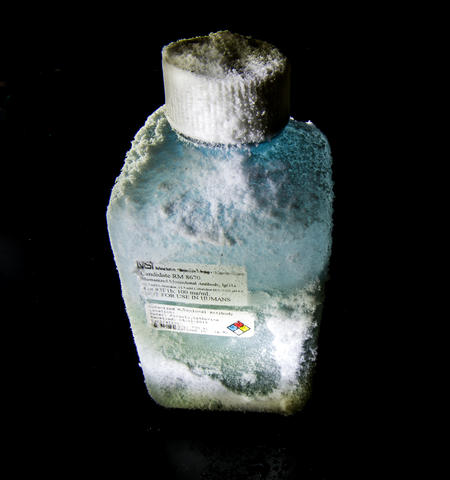
NIST's monoclonal antibody reference material, NIST RM 8671, is shipped in cryovials packaged in dry ice. It should be stored in a frozen state at -80 °C (-112 °F). Shown is a sample that underwent extensive round-robin testing by more than 100 collaborators before the biological material, donated by MedImmune, was certified as a NIST RM.
Manufacturing a monoclonal antibody drug on a large scale is complex and involves the use of genetically engineered cells that churn out large quantities of the molecule. Testing to make sure that the molecules are being made correctly happens at many points in the manufacturing process. The NIST SRM is an important tool for assuring the quality of these test methods and of the final product.
And, since patents on many monoclonal antibodies are set to expire in the next several years, many anticipate a growing market for biosimilar—or generic—versions of the drugs. Generics could save patients billions of dollars by 2020.
But, this will mean a lot of testing and measurements to determine whether these generic versions are nearly identical to the branded versions. The NIST monoclonal antibody SRM could help with measurement challenges faced by researchers tasked with testing these drugs.
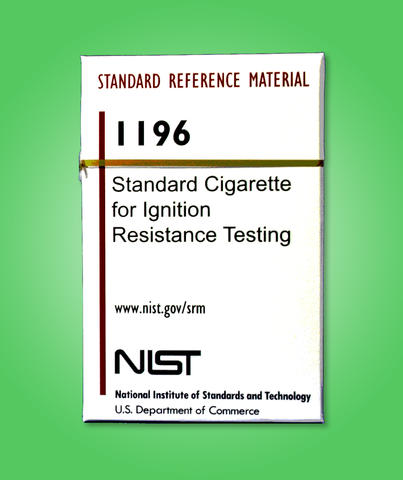
Weird SRM: Standard Cigarette
For over 40 years, manufacturers have been testing upholstered furniture and mattresses to show that a lit cigarette can’t set them on fire. The cigarette they’ve used is one NIST identified as the hottest burning.
Since this testing began, there’s been a marked reduction in the number of fire-related deaths and injuries in the United States.
More recently, governments have passed new regulations that require cigarettes to be less likely to cause ignition; that is, to burn less hot and go out more easily. This new generation of cigarettes has further reduced fire deaths, saving an additional 400 lives per year.
While this is a positive development, it also means that the cigarette NIST sold as a SRM is no longer commercially manufactured.
Because the fire-resistance of furniture and beds still needs to be tested to the same standard as they have been for the past 40 years, NIST has a cigarette specially produced, SRM 1196, which burns as hot as the original.
Furnishings manufacturers use this SRM to verify that their products meet mandatory and voluntary fire safety standards.
Taking measurements to court
In 1978, Michael Hanline was found guilty of murder in California. But Hanline always said he was innocent. Eventually, the California Innocence Project at California Western School of Law took up his case, and through DNA analysis, showed that Hanline was not the source of DNA found on key evidence.
Hanline spent 36 years in prison. He is the longest-serving wrongfully convicted person in California history.
When Hanline was convicted, the ability to evaluate DNA evidence didn’t yet exist. But today, it’s not uncommon to hear of cases where DNA evidence makes or breaks the case. And not just to exonerate the innocent. Far more often, DNA evidence helps law enforcement put away the right people the first time.
NIST forensic DNA SRMs are crucial to this process. They help make sure that labs conducting forensic DNA analysis obtain accurate results. The Federal Bureau of Investigation requires that forensic DNA testing laboratories meet certain quality assurance standards. Labs must check their processes with a NIST SRM (or a reference material that traces back to NIST) every year or anytime they make substantial changes to their protocol.
“The NIST DNA SRM we use in our lab is essential to ensure our analyses are reliable,” said Todd Bille, DNA technical leader at the Bureau of Alcohol, Tobacco, Firearms and Explosives. “With all the advances in the forensic community, NIST SRM 2391c is the only set of DNA samples that has what we need to make sure the analyses function properly in our hands. Our lab is also constantly evaluating new methods to handle DNA. Having this set of standard DNA samples allows us to be sure new methods don’t adversely affect the results.”
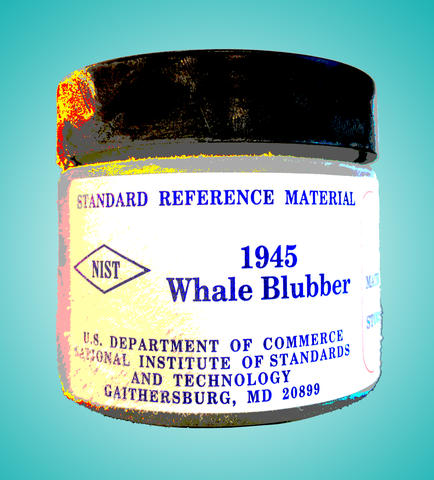
Weird SRM: Whale Blubber
Pilot whales have an unfortunate propensity for beaching themselves. While scientists are puzzled as to why this happens, it does afford them the opportunity to collect samples of their vascularized adipose tissue, or blubber.
Because humans and pilot whales are both mammals, our tissues are pretty similar. Blubber is a lot like human fat, except it tends to have more blood vessels. This makes it a more effective insulator against cold ocean temperatures and helps with diving and surfacing. Because these whales are top predators, the chemicals and pollutants such as PCBs and pesticides that accumulate in their blubber give an indication of the health of the ocean environment and of the creatures that live in it.
The National Oceanic and Atmospheric Administration (NOAA) asked NIST to prepare SRM 1945 back in 1994. Altogether, the SRM contains values for about 70 contaminants, and scientists add new values as necessary.
Most recently, NIST chemists measured values for brominated flame retardants.
So, while this SRM is kind of gross and a little sad, it provides us with a way to monitor the health of our oceans, an irreplaceable natural resource.
Cementing quality control
First of all, John Sieber wants you to know: There's a difference between cement and concrete.
"People get the two mixed up," says Sieber, a NIST research chemist. "Cement is what you have before, and then you mix it with water and sand and gravel—aggregate, they call it—and you pour it into your sidewalk and it hardens through a chemical reaction and becomes concrete."
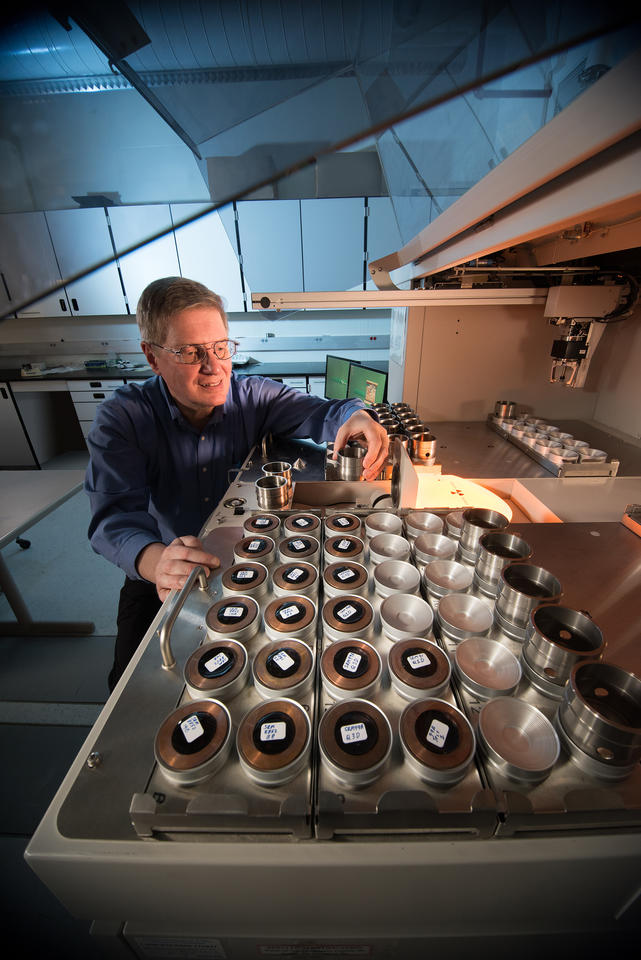
NIST researcher John Sieber, concrete SRM development.
Though you may have never given it a second thought, you no doubt interact with concrete on a daily basis as you drive to work, park your car in a garage, walk across the sidewalk to your office and sit at your desk in a high-rise building.
"The human race is trying to cover the planet in concrete," Sieber jokes.
To make sure their product can withstand the tests of time, wear and weather, cement makers conform to certain quality standards. During the manufacturing process, cement makers test their products hourly. NIST SRMs are crucial to letting manufacturers know the results of their tests are accurate—and that they're creating a high-quality product.
NIST sells 15 cement—not concrete—SRMs that help manufacturers ensure their products meet certain quality standards and help buyers know they're getting what they paid for.
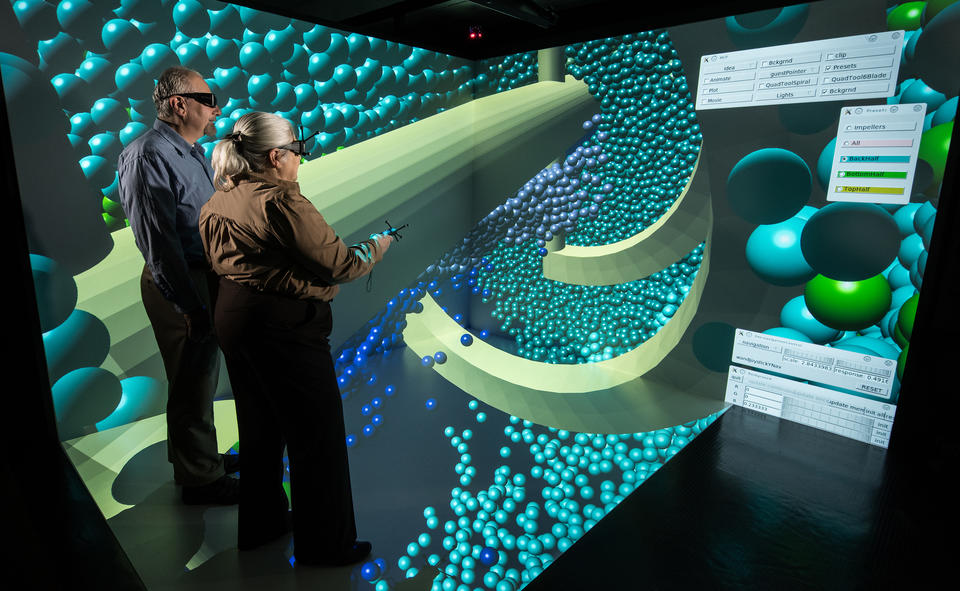
NIST researchers in CAVE 3D Visualization lab exploring the movement of concrete particles.
Standards of excellence
To tell the story of SRMs is to tell the story of industry in America—its breakthroughs and its setbacks. From the turn of the 20th century onward, NIST stood with American makers as they erected skyscrapers, laid railways and took to the skies in airplanes. NIST helped manufacturers overcome technical challenges they faced in bringing innovative technology to the American people.
In 1905, NIST—then known as the National Bureau of Standards—began preparing and distributing the first SRMs, standardized samples of iron, which manufacturers used as a check on their lab analyses. From those early standard samples, the program grew.
Today, NIST still sells versions of these original SRMs, but it has come a long way. The diverse array of SRMs currently available reflect the complexity and technological advancement of a 21st-century society—and the new challenges it faces.
NIST constantly works to improve its existing SRMs to adapt to changing needs—such as the arsenic levels added to the rice flour SRM, or the blueberry SRM, to which NIST is in the process of adding measurements for anthocyanins, a type of flavonoid, or pigment, in the blueberries that contributes to its antioxidant properties. And, NIST is always looking for opportunities to create new SRMs to drive innovation in emerging markets, like the monoclonal antibody SRM for biopharmaceutical manufacturers.
“Good science is our carrot,” Choquette says.
Speaking of carrots, we’ve got an SRM for that.
To learn more about NIST's Standard Reference Materials, visit www.nist.gov.

